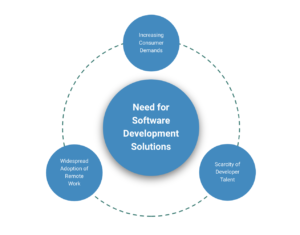Offshore Software Development: 3 Reasons to Invest Now
With the first quarter of 2022 right around the corner, budgeting and planning for the new year is already underway at most organizations.
Software development and product teams may be asking big-picture questions like:
- How can I scale my team’s capacity to be more productive?
- How can we accelerate product releases on a consistent schedule?
- How can we better incorporate emerging technologies like AI and machine learning?
- How can we streamline and improve our QA testing?
With IT budgets generally increasing,* teams will need to strategically invest in the right systems and talent. They must gain a competitive advantage in the growing tech ecosystem.
Offshore software development is one way to push budgets further and fill talent gaps to solve for the big picture questions above. With sweeping changes from COVID-19, offshore development is–now, more than ever–an enormous opportunity for companies looking to drive growth.
But why is now the optimal time to invest in an offshore development partner?
Why Now? The Value of Offshore Software Development
Offshore software development enables onshore teams to:
- Expand their support hours,
- Fill internal talent and skills gaps
- Create continuous development cycles
Quality offshore software development providers include senior level engineers and developers. Additionally, they should take a strategic and consultative approach.
As such, a good provider is the difference between a simple increase in personnel and an end-to-end product enhancement. It should be an extension of your team with a customized approach.
Especially when the right partner is on board.
Offshore development more viable, more accessible, and more impactful than before. Why? Three key factors have converged:
- Companies have already invested in infrastructure for remote work.
- Consumer expectations have increased. So too has pressure on development and product teams.
- There’s an onshore talent scarcity for more senior level engineers and software developers, leaving teams with open gaps in skillsets.

Let’s discuss each of these points in more detail.
Ready to invest in an offshore software development partner? Contact us for a free consultation today.
1. Remote work is more accessible than ever
To stay afloat during COVID-19, most companies adopted tools, technologies, and systems to make remote work viable. Efficient communication channels like Slack and security measures like VPNs created the infrastructure.
Along with upgrades to legacy systems, COVID-19 has forced teams to undergo rapid change management. Employees have gained exposure to collaborative remote work. They’ve forged effective workflows through trial and error.
Even as some companies are returning to the office or testing hybrid models, the foundation for successful remote work is there–and it’s unlikely that software companies can do away with it entirely.
Remote work has become less of a perk and more of an expectation for competitive software developers and engineers. Even purely onshore companies may need to maintain remote work as a condition of retaining and attracting top talent.
The current state of work presents an advantage to those who look to offshore developers. They can broaden their talent pool at a lower cost, while seamlessly integrating onshore and offshore teams.
Offshore developers will be among other remote colleagues. Their ramp-up time is less likely to be hindered by virtual workflow adjustments. Essentially, remote work has lifted a barrier to the skilled, senior level developers in tech-forward countries like Vietnam.
Arguably, remote work is here to stay. Together, all three factors heighten the urgency to invest in offshore talent now.
2. Consumer expectations continue to increase
Software development teams face increasing pressure as consumers expect more from their software. Polished products and customized experiences are becoming table stakes.
At the same time, product teams are tasked with getting products to market as quickly as possible. It can often feel like a tenuous balance between speed and quality as release deadlines approach. Features are cut, legacy systems linger, and innovations are kicked to future releases.
Meanwhile, the needs of consumers are constantly evolving.
For example, target markets for analytics and other B2B software have shifted from technical roles to hybrid roles. Marketing and sales teams are now direct consumers of analytics. As a result, business intelligence platforms must become more intuitive. No-code solutions and in-app guidance are now criteria for staying competitive. These evolving requirements mean those who can pivot and serve these needs first can gain a significant foothold in the market.
The ability to adapt quickly to a changing market, meet demand, and fill consumer gaps can make the difference in gaining or losing market share.
However, asking strapped software development teams to work longer hours is a great way to induce burnout and turnover. Additionally, more hours from software developers doesn’t equate to an increase in specialized skills.
The best way to create such an agile software development team is to structure the team around the right skill sets at the right time. That means continuous development cycles that don’t pause overnight. That means pulling in specialists and senior skilled engineers to optimize entire QA testing processes. More entry level developers are not enough.
Precision and targeted talent move the needle on product quality and speed-to-market.
Offshore development can fill these gaps and relieve pressure on onshore teams. All while meeting consumer demand.
3. Talent shortages make onshore hiring a challenge
Hiring more talent is far easier said than done. Senior-level developers and engineers are incredibly competitive candidates. Not only do they require high compensation, but the hiring process itself can be time-consuming.
The Great Resignation has left many organizations struggling to fill vacant positions, let alone grow their teams. With remote work becoming the norm, candidates are being recruited from all areas of the country.
Companies are competing for talent in ways they’ve never had to before. With consumer expectations increasing, teams can’t slow down production or sacrifice quality.
They simply need more talent.
As such, offshore development teams are the perfect opportunity to diversify teams’ talent pools. Without the significant cost associated with a single senior engineer.
With the convergence of these three factors, now is the optimal time to invest in an offshore software development solution. The combination of widespread acceptance of remote work, increasing consumer expectations, and a tech talent shortage has left companies with an enormous opportunity–if they choose to harness it.
Ready to experience the benefits of an offshore software development partner? Contact us for a free consultation today.
Citations:
* The 2022 State of IT Report, Spiceworks Ziff Davis








